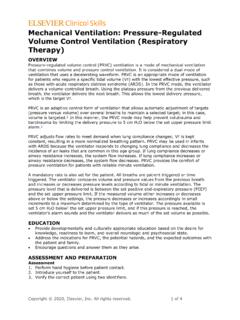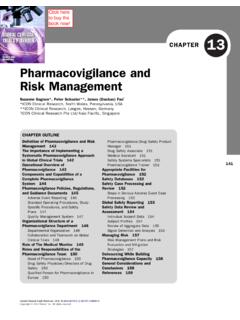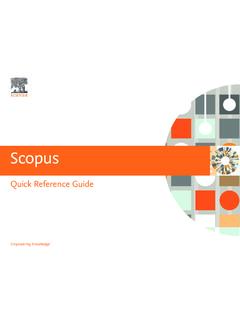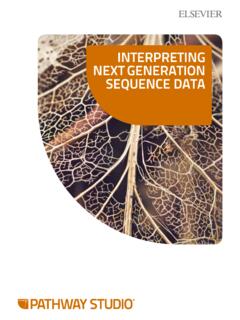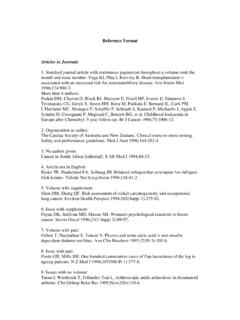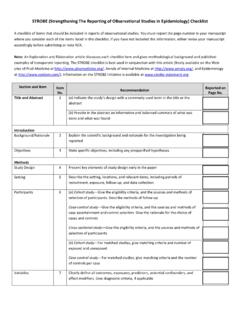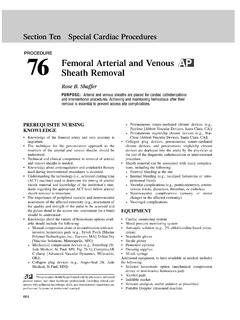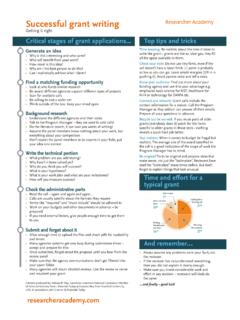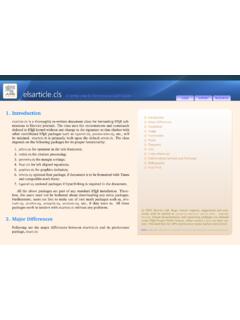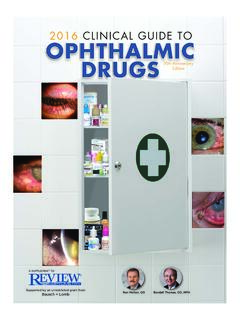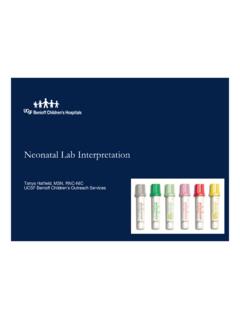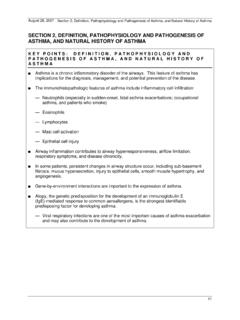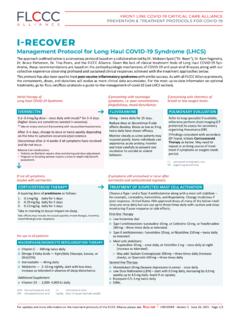Transcription of Antineoplastic Drug Administration: Vesicant and Irritant ...
1 Antineoplastic drug administration : Vesicant and Irritant Agents (Oncology) - CE Copyright 2020, Elsevier, Inc. All rights reserved. 1 of 16 ALERT Don appropriate personal protective equipment (PPE) based on the patient s signs and symptoms and indications for isolation precautions. Refer to Oncology Nursing Society (ONS) interim guidelines for PPE recommendations during an emergent shortage of PPE ( , pandemic).16 Vesicant agents may cause severe tissue damage, including necrosis, if they extravasate into tissue. Only qualified physicians, physician assistants, advanced practice registered nurses (APRNs), or registered nurses with demonstrated competency administer Antineoplastic therapies. Refer to the professional s regulatory scope of practice and the organization s practice. Remember to route tubes and catheters having different purposes in different, standardized directions ( , IV lines routed toward the head; enteric lines toward the feet).
2 This is especially important in the care of Take steps to eliminate interruptions and distractions during medication preparation. OVERVIEW Some Antineoplastic agents may be classified as a Vesicant , others as an Irritant , and some as an Irritant with Vesicant properties, depending on the effect on surrounding tissue when the agent leaks outside the ,17 A Vesicant (Box 1) is any drug that has the potential to cause tissue damage when leakage occurs outside the Box 1 Examples of Vesicant Chemotherapy Agents Alkylating agents: DNA binding Nitrogen mustard Anthracyclines: DNA binding Daunorubicin Doxorubicin Epirubicin Idarubicin Antitumor antibiotics: DNA binding Dactinomycin Mitomycin-C Taxanes: Non-DNA binding Docetaxel Paclitaxel Vinca alkaloids: DNA binding Vinblastine Vincristine Vinorelbine Vindesine (From Jackson-Rose, J. and others. [2017]. Chemotherapy extravasation: Establishing a national benchmark for incidence among cancer centers.)
3 Clinical Journal of Oncology Nursing, 21[4], 438-445; Onesti, and others. [2017]. Chemotherapy extravasation management: 21-year experience. Annals of Plastic Surgery, 79[5], 450-457.) Vesicants cause blistering, pain, skin sloughing, and tissue damage that progresses to necrosis. Damage can occur to underlying tendons and nerves, causing permanent damage Antineoplastic drug administration : Vesicant and Irritant Agents (Oncology) - CE Copyright 2020, Elsevier, Inc. All rights reserved. 2 of 16 that results in severe disability and discomfort. In some instances, permanent nerve damage, loss of a limb, or death can ,12 The exact incidence of chemotherapy extravasation varies greatly because of the lack of reporting of events and the lack of a centralized registry. Overall incidence is estimated to range from to and from to with central venous An Irritant is a drug that causes inflammation in the vein wall; however, it does not cause tissue damage (Box 2).
4 17 Box 2 Examples of Irritant Antineoplastic Agents* Alkylating agents Bendamustine Carboplatin Carmustine Cisplatin Cyclophosphamide Dacarbazine Ifosfamide Melphalan Oxaliplatin Antimetabolites Cytarabine Fludarabine 5-fluorouracil Gemcitabine Methotrexate Other Bleomycin Bortezomib Carfilzomib Dexrazoxane Etoposide Ipilimumab Irinotecan Liposomal doxorubicin Mitoxantrone Nivolumab Topotecan *Although recognized as irritants, these drugs can cause tissue necrosis in some instances, especially if large amounts are extravasated. (From Jackson-Rose, J. and others. [2017]. Chemotherapy extravasation: Establishing a national benchmark for incidence among cancer centers. Clinical Journal of Oncology Nursing, 21[4], 438-445; Pluschnig, U. and others. [2016]. Extravasation emergencies: State-of-the-art management and progress in clinical research. MEMO: Magazine of European Medical Oncology, 9[4], 226-230.)
5 Onesti, and others. [2017]. Chemotherapy extravasation management: 21-year experience. Annals of Plastic Surgery, 79[5], 450-457.) Irritants may cause a burning sensation. A flare reaction causes transient erythema along the vein proximal to the IV site that is thought to be from a local release of histamine . This reaction may cause local pruritus, urticaria, or a red ,15 Irritants that have Vesicant properties can cause tissue damage. With vesicants, tissue damage occurs based on the mechanism of ,17 Deoxyribonucleic acid (DNA) binding drugs, such as anthracycline, attach to the nucleic acids in the DNA tissue surrounding the vein. Progressive cell death and tissue injury occur over time as local cells die and the drug complexes are released and taken up by healthy cells. Non-DNA binding drugs, such as vinca alkaloids, do not attach to DNA within the surrounding Subsequently, indirect damage occurs immediately in the tissue outside the vein.
6 Because these drugs do not bind to the DNA, these agents are metabolized in the tissue and are easily neutralized as compared with DNA-binding Antineoplastic drug administration : Vesicant and Irritant Agents (Oncology) - CE Copyright 2020, Elsevier, Inc. All rights reserved. 3 of 16 Preventing an extravasation requires recognition of risk, preparation, planning, and insight. Extravasation management procedures must be within current guidelines, with antidote order sets developed and the known antidote readily available if needed in the event of an ,10 Only nurses who have received specialized training should give Vesicant agents. Nurses must be able to identify factors that increase the patient s risk for an extravasation (Box 3).13 Box 3 Risk Factors for Extravasation Patient-related Altered sensory perception Compromised circulation Deeply implanted port Exposure to non chemotherapy agent Irritant ( , potassium chloride, calcium chloride) Highly mobile and active History of repeated peripheral chemotherapy administration or multiple venipunctures Impaired communication skills or cognition Inadequate education or poor understanding of information Lymphedema Pediatric or geriatric patient Poor or no blood return from IV site or VAD Poor venous access Obese patient with deep veins Small or fragile veins Treatment duration Nurse-related Extensive experience giving vesicants during which no extravasations have occurred (therefore, improper assumption that skill level will prevent any future extravasations)
7 Failure to identify patients at risk for extravasation Improper venipuncture technique Improper Vesicant administration Inexperience with giving vesicants Interruptions during Vesicant administration IV site selection (dorsum of hand, wrist, antecubital area) Lack of time Lack of training Device-related Fibrin sheath at VAD catheter tip Improper port needle placement Migration of VAD catheter tip Pinch-off syndrome of VAD catheter Use of a device without adequate blood return drug -related Concentration Duration of infusion Antineoplastic drug administration : Vesicant and Irritant Agents (Oncology) - CE Copyright 2020, Elsevier, Inc. All rights reserved. 4 of 16 Route (infusion versus push) Vesicant properties Volume of dilution VAD, venous access device (From Jackson-Rose, J. and others. [2017]. Chemotherapy extravasation: Establishing a national benchmark for incidence among cancer centers. Clinical Journal of Oncology Nursing, 21[4], 438-445.)
8 Kreidieh, , Moukadem, , El Saghir, [2016]. Overview, prevention and management of chemotherapy extravasation. World Journal of Clinical Oncology, 7[1], 87-97.) Once these factors are identified, the nurse can begin to implement preventive strategies to reduce extravasation risks (Box 4).12,13 Box 4 Prevention of Extravasation Provide adequate patient education about extravasation. Maintain annual competencies to validate nursing practice. Avoid extremities with impaired circulation, such as that caused by lymphedema. Avoid sites such as the hand, wrist, or antecubital fossae. Use VADs for Vesicant administration , continuous infusions of vesicants, anticipated long-term administration of chemotherapy, poor venous access, and for children or older adult ,b Ensure clear visualization of the site throughout the infusion. Closely inspect the venipuncture or VAD site for erythema and swelling and note the patient s complaints of pain or ,b Maintain free-flowing IV fluid in which to dilute the injected or piggybacked chemotherapy agent.
9 Ensure good blood return from the peripheral or VAD line. Avoid using a VAD without a blood return until patency has been verified (as with a dye study). Use a large vein for peripheral administration , and ensure patent access. Select an appropriate cannula type and size. Insert a new IV line (if more than 24 hours old).a,b Secure the IV site or needle within an implanted port. VAD, venous access device a. Mini Gill, J. and others. (2018). Venous flare reactions: A case report of reactions following etoposide infusion. Clinical Journal of Oncology Nursing, 22(6), 597-599. b. Olsen, , LeFebvre, , Brassil, (Eds.). (2019). Chemotherapy and immunotherapy guidelines and recommendations for practice. Pittsburgh: Oncology Nursing Society. Nurses administering IV Antineoplastic therapy must be alert to patients at risk for extravasation, as well as the signs and symptoms of an extravasation (Box 5). Patients should be taught to report any symptom that occurs during Antineoplastic administration .
10 The nurse should investigate each concern verbalized by the ,11 Antineoplastic drug administration : Vesicant and Irritant Agents (Oncology) - CE Copyright 2020, Elsevier, Inc. All rights reserved. 5 of 16 Box 5 Signs and Symptoms of Extravasation acute Erythema Feelings of coolness around site Infusion slows or stops Loss of blood return from IV line or VAD Pain, burning, stinging Swelling at site Delayed Blistering, ulceration Discoloration, induration Dry desquamation, peeling and sloughing of skin Functional impairment Increased erythema Increased pain Necrosis, eschar formation Sensory impairment at site of extravasation Although extravasation can be prevented in most cases, leakage can occur despite all measures instituted to reduce the risks. Typically, venous access devices (VADs), such as implantable ports, peripherally inserted central catheters (PICCs), nontunneled catheters, and tunneled catheters reduce the risk for Nevertheless, extravasation from these devices can occur, causing severe tissue damage to the antecubital area of the arm from PICCs or peripheral ports or to the chest wall, mediastinum, or pleural space from other An extravasation kit can be useful to provide care in a timely manner in the event of an extravasation.
